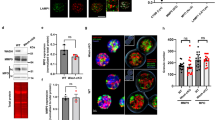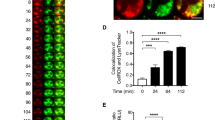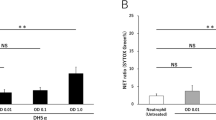Abstract
THE human polymorphonuclear leukocyte (PMN) contains two types of cytoplasmic granules, specific or heterophil granules and azurophil granules1. These granules contain enzymes and various non-enzymatic proteins. The specific granule contains alkaline phosphatase and most of the lysozyme of the cell while the azurophil granule contains the acid hydrolases and other enzymes which identify it as a lysosome1. Recent work2 has shown that in the degranulation accompanying phagocytosis the specific or heterophil granules combine with the phagosome first, followed by the azurophil granules. This implies that degranulation may be a complex event with more than one signal involved. If this were true then one might expect that the events should be separable, that is, that one type of granule might be stimulated and the other little affected. Experiments in our laboratories have indicated that only one type of PMN granule responds to phorbol myristate acetate (PMA). Five minutes after application of nanogramme quantities of the agent the cell begins to show large intracellular vacuoles. Granules which demonstrate an alkaline phosphatase reaction disappear in 30 min while those staining for myeloperoxidase remain3. Here we report that PMA causes both a dose and a time dependent release of enzyme activity associated with specific granules while those associated with azurophil granules or lysosomes remain associated with the cell as did a cytoplasmic marker enzyme glucose-6-phosphate dehydro-genase.
This is a preview of subscription content, access via your institution
Access options
Subscribe to this journal
Receive 51 print issues and online access
$199.00 per year
only $3.90 per issue
Buy this article
- Purchase on Springer Link
- Instant access to full article PDF
Prices may be subject to local taxes which are calculated during checkout
Similar content being viewed by others
References
Bainton, D. F., and Farquhar, M. G., J. Cell Biol., 39, 286 (1968).
Bainton, D. F., J. Cell Biol., 58, 249 (1973).
White, J. G., and Estensen, R. D., Am. J. Path. (in the press).
Holmes, B., Page, A. R., and Good, R. A., J. clin. Invest., 46, 1422 (1967).
Baehner, R. L., and Karnovsky, M. L., Science, 162, 1277 (1968).
Holmes, B., Day, N., Haseman, J., and Good, R. A., Infect. Immun., 5, 232 (1972).
Fruton, J. S., J. biol. Chem., 166, 721 (1946).
Hirschhorn, R., Hirschhorn, K., and Weissman, G., Blood, 30, 84 (1964).
Goldberg, N. D., Haddox, M. K., Estensen, R. D., White, J. G., Lopez, C., and Hadden, J. W., in Cyclic AMP in Immune Response and Tumor Growth (edit. by Lichtenstein, L., and Parker, C.) (Springer-Verlag, in the press).
Estensen, R. D., Hill, H. R., Quie, P. G., Hogan, N., and Goldberg, N. D., Nature, 245, 458 (1973).
Henson, P. M., and Oades, Z. G., J. Immun., 110, 290 (1973).
Columbo, C., Ignarro, L. J., and Chant, J. K., Fedn Proc., 32, 291 (1973).
Zurrier, R. B., Tynan, N., and Weissmann, G., Fedn. Proc., 32, 744 (1973).
Author information
Authors and Affiliations
Rights and permissions
About this article
Cite this article
ESTENSEN, R., WHITE, J. & HOLMES, B. Specific degranulation of human polymorphonuclear leukocytes. Nature 248, 347–348 (1974). https://doi.org/10.1038/248347a0
Received:
Revised:
Published:
Issue Date:
DOI: https://doi.org/10.1038/248347a0
This article is cited by
-
Participation of serum proteins in the inflammation-primed activation of macrophages
Inflammation (1994)
-
In vivo and in vitro activation of macrophages with a cyanine photosensitizing dye, platonin
Cancer Immunology Immunotherapy (1993)
-
Stimulated release of neutral proteinases elastase and cathepsin G from inflammatory rat polymorphonuclear leukocytes
Inflammation (1987)
-
Protein kinase C activation of physiological processes in human neutrophils at vanishingly small cytosolic Ca2+ levels
Nature (1984)
-
Tierexperimentelle untersuchungen zur rolle von entzündungsmediatoren bei der hornhautneovaskularisation
Documenta Ophthalmologica (1984)
Comments
By submitting a comment you agree to abide by our Terms and Community Guidelines. If you find something abusive or that does not comply with our terms or guidelines please flag it as inappropriate.



